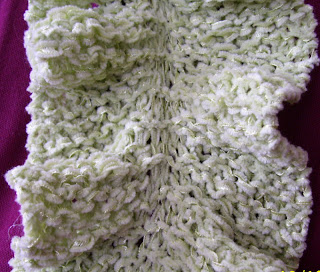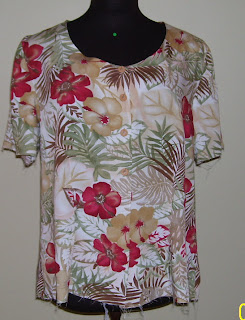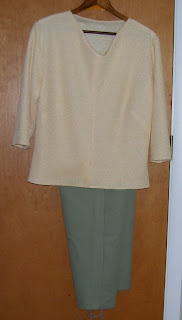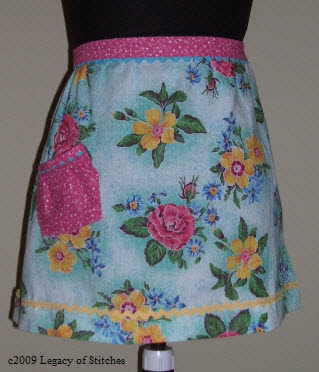I found several patterns -- and the name can mean a couple things. One, it looks like a long curly fry. Two, you can't stop at just one.
Basically it is a knitted flounce that can be worked to any length. The first pattern is done on a circular needle and casts on anywhere from 50 to 110 (or more) stitches. The scarf is knitted in garter stitch a total of 8 long rows, with every other row doubling the stitches by knitting an increase in each stitch. Another pattern casts on only 20 to 24 or so stitches and is worked in a series of short rows (stopping part way and then turning the work and knitting back to the beginning of the row).
The problem I had was determining if I had enough of any one yarn to work the long scarf. It is definitely the eaiser pattern since you don't have to do any counting -- just sit and knit. I figured if I did the short-row version I could just keep knitting until it was the length I wanted or I ran out of yarn.
So I did a test of the first short-row pattern. I have ~240 yds of a discontinued yarn -- Sensations Carlo that is described on the label as a "versatile shimmering tape yarn."
The pattern beautiful and actually makes a double flounce. But I could tell I didn't have enough yarn to make a scarf long enough to be usable. Maybe I could make it long enough to attach to a garment as a collar .. but that's not my style.
I have another pattern I am going to try -- later, after the holidays -- that will make a single flounce and I will be able to use all the yarn to whatever length it ends up being. But, I wanted to make a gift and the giftee's (is that a word?) favorite color is blue.
So I found some yarn in the stash that had plenty of yardage and is a combo of blue & black -- so good to wear with jeans. I decided to cast on 90 stitches (size 11, 36" circular needle). On the increase rows that became -- 180 -- 360 -- 720 stitches -- and ended up a length ~5 ft total. I did a sample starting with 10 st (20 - 40 - 80) to make sure I would like the end effect with my yarn and needle size (tried a couple different needle sizes so I'd know what size to buy in the 36" circular) and then worked on the real one. You don't see the flouncing effect until you are finished and start to bind off.

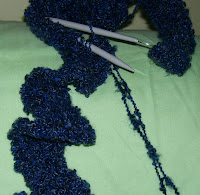
and VOILA -- the finished scarf -- ready to be wrapped and shipped ....
This was an easy project -- one row all you do is knit. The next row you increase by knitting in front and back of each stitch. No counting! But by the end if you can't work an entire row in a sitting, with the yarn I was using (Yarn Bee, Boucle Traditions) it was hard to tell if I was on a straight knitting or an increase row. So when I would leave the work, I would leave myself a note stuck to the needles.
Since I have another ball of this yarn -- I am going to make another for my daughter to go with her new black jacket ... and then I'll work on my green one ... and then ... (can't stop at just one!)

